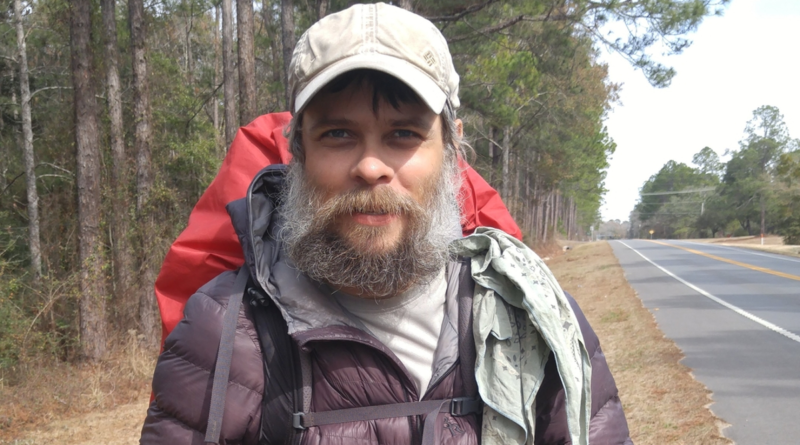Vance John Rodriguez “Mostly Harmless” Death in Collier County Florida
On July 23, 2018, in the remote wilderness of Collier County, Florida, a discovery would spark one of the most perplexing and talked-about cases in recent forensic and investigative history. The remains of a hiker, later identified as Vance John Rodriguez and known by the trail moniker “Mostly Harmless,” were found in a yellow tent. This case not only highlighted the advancements in forensic science and genetic genealogy but also stirred a complex conversation about modern isolation, mental health, and the mythmaking of our digital era. Over the years, his story has evolved from an unsolvable mystery to a poignant reflection on a life marred by inner turmoil and deliberate disappearance from the digital world.
The Mysterious Discovery
On that fateful day in late July 2018, local authorities in Collier County were called to investigate an unusual scene in the Florida wilderness. In an area where nature’s raw beauty contrasts starkly with modern civilization, the discovery of an abandoned yellow tent quickly caught the attention of law enforcement. Inside, they found the emaciated remains of a man who had clearly been living in isolation. There were no immediate personal identifiers—no wallet, no phone, and no visible identification documents. Instead, what lay before the investigators was a trail of enigmatic clues: scattered notebooks filled with computer codes, cash amounting to several thousand dollars, and a modest supply of food. The scene was perplexing; it told a story of someone who had deliberately chosen a life off the grid, one that left behind an almost digital footprint-free existence.
Early Investigative Challenges
From the outset, the case posed a number of challenges for local law enforcement. In a world where most individuals are easily traceable through their digital devices, credit card transactions, and social media profiles, the hiker had managed to erase almost all signs of his conventional identity. His fingerprints did not match any records in the databases, and facial recognition technology yielded no clues. Traditional investigative methods were stymied by his deliberate disconnection from modern conveniences. The physical evidence left behind was sparse and enigmatic—a set of personal effects that spoke of a man who, despite his solitary existence, once participated in a world governed by digital traces.
Investigators were left to ponder how someone could vanish so completely in the modern age. As weeks turned into months, the case began to capture the attention of not only local authorities but also amateur sleuths and the broader public. Social media groups and online forums dedicated to solving cold cases sprang into action, sharing photos and details in hopes of piecing together the life of the elusive hiker. The collective digital curiosity surrounding the case gave birth to the nickname “Mostly Harmless,” a moniker that both encapsulated his unassuming appearance and the mystery that cloaked his existence.
The Life of Vance John Rodriguez
It wasn’t until later investigations that the true identity of “Mostly Harmless” began to emerge. Vance John Rodriguez, a native of Lafayette with roots deeply embedded in the Cajun culture of Louisiana, was revealed to have led a life that was as complicated as it was enigmatic. Born into a family with its share of challenges, Rodriguez’s early life was marked by trauma and a persistent struggle with mental health. A near-suicidal incident during his teenage years left an indelible mark on him—a physical scar and a psychological one that would follow him into adulthood.
By all accounts, Rodriguez was a man of dualities. On one hand, he was described by those who encountered him on the trail as warm, approachable, and strangely insightful, with an almost magnetic personality that drew fellow hikers into brief yet meaningful connections. On the other hand, acquaintances from his past recalled a darker side: a person who had battled severe depression, engaged in self-destructive behaviors, and had even been accused of exhibiting abusive tendencies in past relationships. This complexity rendered him a subject of both empathy and enigma. His deliberate erasure of a digital footprint, his choice to carry cash rather than use credit, and his complete absence from modern tracking mechanisms all pointed to a man who had consciously rejected the trappings of contemporary society.
The Mysterious Trail and Isolation
Vance Rodriguez’s disappearance into the wild was not simply an act of evasion from society; it was also a journey into the depths of personal isolation. His choice to traverse the Appalachian Trail and other wilderness areas was emblematic of a deeper, internal quest. For many, hiking is a means of reconnecting with nature—a way to find clarity amid the chaos of everyday life. For Rodriguez, however, the trail became a stage for a radical transformation. He was not merely a wanderer; he was someone who had consciously chosen to live at the margins of society, leaving behind a conventional life to confront his inner demons alone.
This voluntary isolation was a double-edged sword. While it granted him the freedom to escape the pressures and expectations of modern life, it also ensured that when tragedy struck, there was no safety net to catch him. His disappearance from the digital grid meant that when his life came to an end, there were no immediate calls from worried family members, nor was there a network of friends to raise the alarm. The hiker’s last days remain shrouded in mystery—was his death an inevitable culmination of his mental struggles, or was it the result of an unforeseen accident in an unforgiving environment?
Forensic Advances and Genetic Genealogy Breakthrough
The turning point in the case came with the advent of cutting-edge forensic techniques and the rise of genetic genealogy. Traditional methods had failed to yield the identity of the mysterious hiker, but a breakthrough came when investigators turned to modern DNA analysis. By extracting genetic material from the remains, forensic experts were able to upload his profile to genealogical databases. This innovative approach allowed them to construct family trees and identify potential relatives, ultimately leading to the confirmation of his identity as Vance John Rodriguez.
This breakthrough was not merely a technological triumph; it also underscored the transformative potential of genetic genealogy in solving cold cases. The success in identifying Rodriguez provided a roadmap for future investigations, demonstrating that even when traditional investigative methods falter, modern science can offer a path to resolution. The case also prompted broader discussions within the forensic community about the ethical, legal, and privacy implications of using genetic data to solve crimes. While many hailed the breakthrough as a victory for justice and closure, others raised questions about the boundaries of personal privacy in the digital age.
The Role of the Hiking Community and Digital Sleuths
One of the most remarkable aspects of the Rodriguez case was the role played by the hiking community and online amateur detectives. Even before his identity was officially confirmed, thousands of internet sleuths had come together on various social media platforms and dedicated forums to share information, analyze photographs, and compile testimonies from fellow hikers who had encountered the elusive “Mostly Harmless.” Their collective efforts were instrumental in keeping the case in the public eye and applying additional pressure on authorities to pursue every possible lead.
Online communities demonstrated both the power and the pitfalls of digital collaboration. While many members were driven by genuine concern and a desire for truth, the anonymity of the internet also allowed for wild speculations and at times, unfounded rumors. Yet, despite these challenges, the overall impact of the digital community on the case was undeniable. Their relentless determination not only accelerated the identification process but also fostered a sense of shared responsibility—a modern, grassroots investigation that transcended traditional boundaries.
Public Reaction and Media Coverage
As details of the case emerged, public interest in the story of Vance John Rodriguez soared. The narrative of a man who deliberately vanished from the modern digital world resonated deeply in an era where privacy and identity are constantly under siege by technology. Major news outlets, including Fox News, CBS, and Time, picked up the story, each offering their own angle on the tragedy. Headlines described him as a man who “didn’t want to be found,” and narratives focused on his apparent rejection of modern society.
Media portrayals of Rodriguez’s life often oscillated between sympathy and criticism. On one side, his decision to live off the grid and his subsequent isolation were seen as a poignant commentary on the pressures of contemporary life—a call to return to nature and seek solace away from digital distractions. On the other, there were voices that critiqued him for the darker aspects of his personality, including allegations of abusive behavior in past relationships. This duality in his portrayal highlighted the broader societal struggle to reconcile the benefits of technological progress with its often dehumanizing consequences.
The Documentary and True Crime Narratives
The enduring intrigue surrounding Vance Rodriguez’s life and death ultimately led to the creation of several documentaries and in-depth true crime investigations. One notable project, “They Called Him Mostly Harmless,” directed by Emmy Award-winning filmmaker Patricia Gillespie, delves into every facet of Rodriguez’s existence. The documentary not only chronicles the investigative journey that led to his identification but also examines the broader implications of his life choices in the context of modern society.
In the film, interviews with fellow hikers, family members (both identified and anonymous), forensic experts, and digital sleuths provide a multi-layered perspective on Rodriguez’s life. The documentary places particular emphasis on the intersection of human vulnerability and technological advancement, exploring how a man could choose to disappear in a time when our digital footprints are nearly impossible to erase. Through its narrative, the film invites viewers to reflect on the nature of identity, the role of community in solving mysteries, and the ongoing debate over privacy in the digital era.
Psychological and Social Reflections
The case of Vance John Rodriguez raises profound questions about mental health, identity, and the nature of modern isolation. For many, the story is a tragic reminder of how societal pressures, personal demons, and the relentless pace of modern life can converge to create a perfect storm of despair. Rodriguez’s life was marked by severe depression and an internal struggle that seemed insurmountable, prompting him to retreat from the world and seek refuge in the solitude of the wilderness.
Psychologists and sociologists have since used his case as a point of discussion in examining the broader implications of living in an age where technology dominates our lives. The deliberate abandonment of digital communication by someone who once thrived in the tech sphere presents a stark irony—a man who was highly skilled in navigating the digital world, yet chose to sever his ties with it when his inner turmoil became too much to bear. His story serves as a somber illustration of how mental health issues can be exacerbated by the isolation inherent in modern society, and how the quest for personal freedom can sometimes lead to tragic consequences.
The Legacy of “Mostly Harmless”
In the wake of his identification, the legacy of Vance John Rodriguez has continued to grow, transcending the realm of true crime to become a symbol of modern paradoxes. The nickname “Mostly Harmless” has taken on a life of its own, representing not only the physical appearance and demeanor of the hiker but also the broader narrative of a man who managed to exist outside the norms of contemporary life. His story has inspired countless discussions about the impact of technology on personal identity, the power of community in solving mysteries, and the enduring human need for connection even in the face of overwhelming isolation.
For the families of cold cases and for forensic professionals alike, Rodriguez’s case stands as a testament to the potential of modern science. The use of genetic genealogy to crack a case that had stymied traditional investigative methods has paved the way for new approaches to solving other long-forgotten mysteries. At the same time, his life serves as a cautionary tale—a reminder that behind every headline, every forensic breakthrough, and every digital footprint, there is a human story filled with complexity, pain, and sometimes, redemption.
Broader Cultural and Digital Implications
The impact of Vance John Rodriguez’s life and death extends far beyond the confines of Collier County, Florida. In an era where the digital footprint of an individual often defines their identity, his case raises important questions about the nature of privacy and anonymity. Many have marveled at how someone could effectively “erase” themselves from a world where every transaction, interaction, and moment is meticulously recorded. This deliberate rejection of modern connectivity challenges conventional wisdom about identity and the self, inviting a reevaluation of what it means to truly “disappear” in the digital age.
Moreover, the phenomenon of internet sleuthing, which played such a critical role in eventually identifying Rodriguez, has become a double-edged sword. While online communities have proven capable of leveraging vast amounts of collective intelligence to solve mysteries, they also raise ethical concerns about privacy, vigilantism, and the spread of misinformation. The case of “Mostly Harmless” underscores the power of community-driven investigation while simultaneously cautioning against the potential for digital mob mentality, where personal tragedies can be sensationalized or exploited for entertainment.
Reflections on Isolation and the Human Condition
At its core, the story of Vance John Rodriguez is a meditation on the human condition—a reflection on the struggles we face in an increasingly interconnected yet isolating world. His life, marked by profound personal battles and a deliberate withdrawal from society, mirrors a growing trend in modern culture: the yearning for simplicity, introspection, and a return to nature. Yet, this same withdrawal often comes at a steep cost, as the absence of a support network can lead to tragic consequences when the weight of isolation becomes unbearable.
For many, the tale of “Mostly Harmless” is both inspiring and heartbreaking. It prompts a deep consideration of how we, as a society, address mental health, foster community, and balance the benefits of technology with its potential to isolate us from genuine human connection. The case challenges us to look beyond the surface of digital personas and to consider the real, often painful, human experiences that lie beneath.
The Impact on Cold Case Investigations and Forensic Science
The identification of Vance John Rodriguez through genetic genealogy marked a watershed moment in forensic science. It demonstrated the immense potential of new technologies to crack cases that were once deemed unsolvable. This breakthrough has spurred a wave of innovation and collaboration among forensic experts, law enforcement agencies, and digital sleuths alike. The methods employed in this investigation have since been adapted and refined, offering hope for resolving numerous cold cases that continue to haunt communities around the world.
This landmark case has also ignited discussions about the future of forensic investigations. As technology continues to evolve, so too will the methods by which we search for truth and justice. The use of DNA analysis, coupled with the power of online databases and community engagement, is setting a new standard for investigative work. In many ways, Rodriguez’s case is a harbinger of a future where the boundaries between traditional detective work and digital forensics become increasingly blurred.
Community Outreach and the Quest for Closure
For the families and communities affected by unresolved cases, the closure provided by the identification of “Mostly Harmless” has been both bittersweet and transformative. While the revelation of Vance John Rodriguez’s identity has finally put a name to a long-standing mystery, it has also opened up a Pandora’s box of emotional and psychological ramifications. For many in the hiking community, his story is a personal tragedy—an emblem of a man who chose isolation over connection, and whose struggles reflect larger societal issues.
The public response to the case has been a mix of relief, sorrow, and introspection. Community outreach initiatives have sprung up in the aftermath of the identification, with many advocates calling for improved mental health support and greater awareness of the challenges faced by those who live on the fringes of society. The legacy of “Mostly Harmless” has, in many respects, galvanized a movement toward greater empathy and understanding in an age defined by technological advancement and digital anonymity.
Conclusion
The tragic death of Vance John Rodriguez, known by many as “Mostly Harmless,” remains a poignant reminder of the complexities of modern existence. His deliberate disappearance from the digital world, his battle with inner demons, and the eventual forensic breakthrough that identified him are all threads woven into a larger tapestry that speaks to the human experience. In a society where every action is recorded and every moment shared online, his story stands as a counterpoint—a call to examine the costs of modern connectivity and the enduring need for human compassion.
As investigators, digital sleuths, and communities continue to reflect on the implications of his life and death, one thing remains clear: the case of “Mostly Harmless” is not just a tale of forensic triumph, but a profound narrative that forces us to confront uncomfortable truths about isolation, identity, and the delicate balance between technology and the human soul.
The legacy of Vance John Rodriguez endures not only in the annals of forensic science but also in the hearts of those who, in his memory, continue to seek a deeper understanding of what it means to be truly human in a world where even the most elusive lives can, eventually, be brought to light.
Discover more from City Towner
Subscribe to get the latest posts sent to your email.




